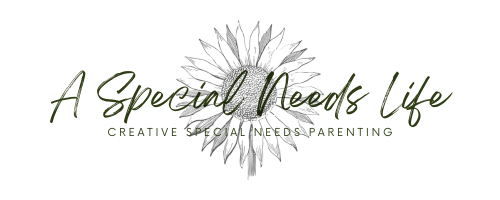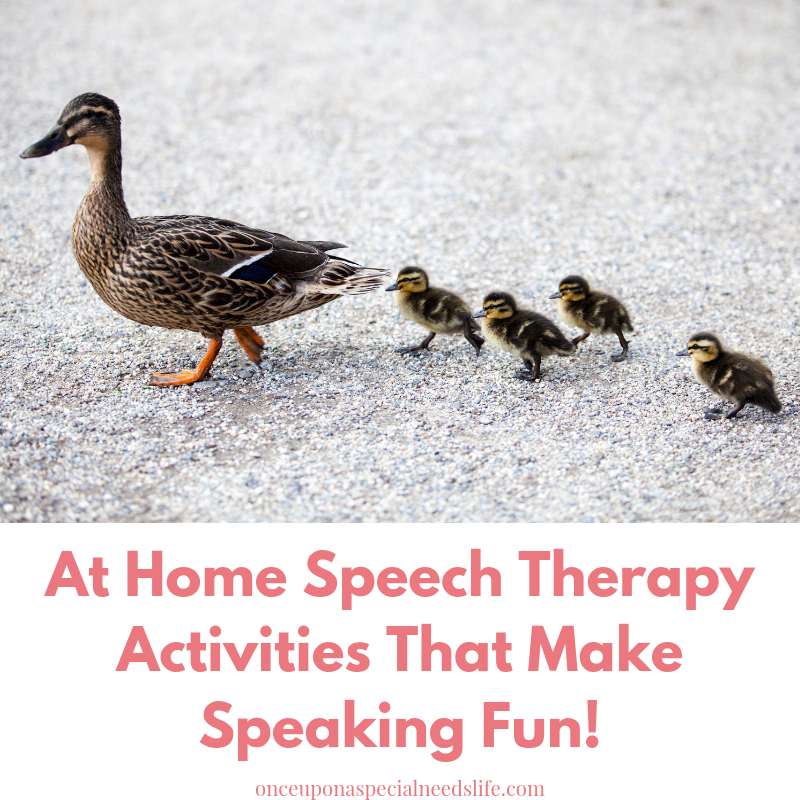As moms, we sometimes needs to create our own sort of home speech therapy. Communication means a lot in our world, and our kids are already at a disadvantage. Getting them talking may be a lifetime mission for us as moms, but it is important.
Apraxia or any other speech disability, keeps special needs kids bound up in silence. Further, physical disabilities or autism may keep them from expressing themselves. Our children’s voices may not be heard for years, some not until they are nearing the end of their lives.
As parents, we remain in a very unique position to unlock our children’s expression. It may take a lifetime, but verbal expression is usually possible.
Why at home speech therapy?
If you are like our area, there is none. Yep. The number of speech therapists per child is really low. Even when we could afford to pay for private sensory integration therapy, which includes speech therapy, they focus more on OT services than speech.
Even if your child attends the public school, speech therapists are stretched far too thin, and cannot meet the huge demand for services.
So, in the daily schedule of life, speech therapy has become part of our regular routine. It does not have to be formal or even rigid. My experience has been that the more fun any learning activity is, including speech, the more success you will have.
At home speech therapy makes speech useful and practical, not clinical. After all, why do we use speech? It serves an everyday purpose and our kids need this to get through in life.
I always recommend using activities that do not frustrate a child at first, to build success. Then, as they get better, I might throw in a challenge or two.
What is a speech disability?
When you have a kid with a speech disability, you have a kid who cannot speak, or struggles to speak. They may even have a disability called apraxia. In general terms, this means that our kids tend to understand much more than they can speak back to us.
Apraxia, specifically is a brain processing problem that creates a disconnect between what kids hear and what they can say. Most kids with apraxia start off in life unable to speak or only able to say a few words.
Auditory processing another language disability problem creates a lack of understanding in what our kids hear. When they cannot understand our language, they cannot process their own language. When that happens, as you can imagine, speaking becomes increasingly shut down.
Often times, they do appear to understand some or most of what people say to them, but they cannot actually engage in actual speech. Littles often engage in tantrums because they don’t know how to say what they want and need.
Think of babies who coo and smile, or tantrum and scream because they have yet to develop speech. Well, a child with a speech disability may understand you, but cannot speak. Or, when they try to speak, things just come out all jumbled up. Then, when they cannot speak they act like young children.
While some claim a level of healing for their child’s apraxia, many others know that apraxia remains a lifetime condition. Will it get better? Yes. Can nonverbal kids learn to speak or at least communicate? Most of the time they do; it just may not happen until adulthood and they may express themselves with communication devices.
So, it isn’t without hope, but like any special condition, it cannot just be fixed.
What are some speech disability MYTHS?
There remain many myths about speech disabilities that the general public does not really understand. What most special needs moms understand is that nonverbal does not mean a human shell. It certainly doesn’t mean they cannot understand anything you say in their presence.
Mental retardation is the problem
Actually, this really isn’t true. Most kids who have speech issues are much smarter than you think. While they may not speak clearly or at all, they do understand much of what is spoken to them. A kid locked inside their head may simply what it is. They may live in silence, but understand the world much better than you think.
The disconnect comes between what they express verbally and what they understand. Talk about frustration! Many children with apraxia know what they want to say, it simply does not come out right.
They never speak
Again, most kids with a speech disability speak eventually, or at least use communication devices. They may never speak normally, or speak in chunky sentences and phrases. Other kids find their voice at young ages (though not normal with apraxia) while still others speak much later into adulthood.
Only a few kids remain nonverbal for the rest of their lives.
They must be deaf
Just because a person cannot speak does not mean they are deaf! Many people asked me this when my son was little. He would ask me questions in sounds, occasional words, gestures and sign language.
While I thought it funny at the time, they were probably right to think so at first. He probably did sound deaf to many people. He actually had highly sensitive hearing when he was little, and still does with some sounds.
What if my child has a speech disability?
This remains a common issue with special needs. Some kids simply cannot loop their minds to their mouths and say one word. Frequently, kids get a speech diagnosis such as apraxia.
Apraxia simply means that what our children understand in their minds struggles to come out verbally. There usually remains a big gap between what apraxic kids understand with their ears and their ability to express themselves.
My suggestion, as a teacher, is to use tools to help them cope with their inability to speak with sign language, picture cards or speech apps or devices. This gives kids some level of communication as they grow.
While I won’t disclaim accounts of children overcoming apraxia, generally speaking, kids with apraxia will develop language over a longer period of time. They need plenty of patience and communication helps so they can express themselves.
The following activities can help them master some speech over time and find their place in the larger world.
How do I know this? Well, because my son has apraxia and started off with almost no language at 18 months. Now, he talks too much! 😉 No, he doesn’t speak normally, but yes, he does communicate most of his wants and needs. Sign language is now something he uses when he cannot retrieve the words he wants to use.

Can you get speech therapy online?
There are several speech therapists who have taken their practices online which you can hire. Most cost about $100 an hour. So, if you can afford it, go for it. There are plenty to choose from!
But, if you are like our family, we cannot, so we use what we have at our disposal. We will go the route of home speech therapy until one shows up who can bridge the gap for awhile.
Here is a short list of online pediatric speech therapists that look good.
Speech Buddies (Not online, but has a speech therapist search engine.)
Tips to Help Speech Communication
So, how do you help your speech disabled kid speak? Well, you can play a lot of games with them, but over-pushing kids can only cause frustration.
I mean, imagine if you cannot do something and someone is always forcing you to do it. How responsive would you be? You can try these speech games and activities to help your kids learn to speak.
But, when it comes to flat out communication, what can you do? Well, there are plenty of speech communication tools to help your kid communicate with the world. And, if they find a way to communicate, they will naturally improve in their speaking skills!
Augmentation Devices
Also known as alternative communication devices, allow the user to select pictures so that the computer can speak the words for them. While these devices have changed over the years, some have become apps, but an augmentation device may be a super useful tool in helping people with speech disabilities communicate.
Simply, a person taps the picture or pictures on the screen and the computer speaks for them. The more physically disabled a person is, the more elaborate they system needs to be. You can check out augmentation devices here, or check with your child’s speech therapist for more information.
Lingraphica has several speech generating devices, which may be covered by insurance.
Sign Language
Sign language is a great method of speech communication because you can take it with you wherever you go. Plus, you don’t have to scramble for a device when your child needs to communicate.
In America, American Sign Language works best, but kids may sign and gesture their own signs too! Choosing the sign language dialect (Oh yes there are!) in your area or country will help your child best communicate with those around them.
Picture cards
While I admit, this system is a bit old-fashioned, it can work in a small setting. Using a communication board with velcro helps a child with speech communication when they want something.
Picture cards also work well if you need to post a schedule on the wall or refrigerator to help your child know what their routine is. Allowing them to place and remove the pictures gives them some level of “control.” Imagine feeling like the world is completely untouchable and unmanageable to, because this is what happens when kids have a speech disability.
Social Media apps
While I guess Facebook and other popular social media accounts may have emoticons, other social communication apps work great for general fun communication.
Using emoticons and images on many of the kid apps helps kids use some level of communication.
Speech activities that won’t break the bank!
Try some of these activities when your kids are just playing or spending time with you. Make it fun and they will take off with their own language.
Encouragement brings much more motivation than forcing a person whose weakness remains forming language to make sounds. Honestly, you are only risking a meltdown if you force someone to that point.
Kids want to share their voice and they want to talk to their peers.
Computer apps
This remains the gold standard for opening up special needs kids. Technology bridges the gap of expression to the rest of the world. Software, usually in the form of an app or other program helps children and adults communicate. But, the tablet itself is a prime bridge to the world outside their own world.
When it comes to speech, I recommend an iPad, even if it is older and used. There are many apps that bridge communication and express it for the child which can only be found on Apple’s IOS system. Kindle Fire is my go-to for entertainment and some educational apps, but Apple has better quality software available for communication.
Speech Blubs is the best app for getting kids to say speech sounds!
ABC Mouse encourages pronunciation of basic letter sounds
Word card games
I don’t mean flash cards either. One of the ways to help kids put speech and words together is showing them the words and object together. Use word cards to label objects you use around the house. This way, the word is not just a word, but it means something. I didn’t say it was attractive! But, it does really work.
You might also use word and picture cards in some fun games like Go Fish or matching games. Games like Uno, the card game, make it fun to say a word like Uno, reverse, add two and so on. My seriously speech impaired son LOVES this game!
With games like these, your kids will begin to see the word in a new context and simply know what it means. Later, they will actually say the word to you!
Board games
Choose board games that help your kids practice speech.
You can also download and print out tons of speech games that you can find on Pinterest. What about general board games where basic communication is required on some level?
Toys
Seriously, who knew? You can use Mr. Potato Head (and Mrs.) to help your kids speak. Asking them what is this? And they tell you, or at least try. Mr Potato Head does help kids learn.
Can you say, “To infinity and beyond?” or, what about “Reach for the skies!” Toy story and other favorite kid movie toys help bridge communication.
Have a toy farm set or Barbie dolls? Use anything to help your child imitate noises or make sounds. Encourage your child to tell you a story about their toys, or make funny sounds! Speech therapists do things like this all the time!

Go on day trips
Even if you don’t homeschool, taking your child to say, a park with ducks or to the Zoo, brings out language in any child. Going outdoors to your backyard with them helps your children get and give you new words for everyday things like pool, swing, dogs, grass, trees, or flowers.
Going to places that excites and intrigues them naturally encourages them to speak. I learned early on in my son’s language development, that sign language with the proper words for things, really helps them learn to communicate!
This brings up an excellent opportunity to give them the words and let them copy you. Works like a charm! 😉
Read road signs
One of the easiest ways to boost a child’s reading and speech confidence is to help them read and identify store signs. One of my son’s first reading words was HEB (the grocery store chain).
This not only helps them speak, but also teaches them that words have meaning. Words, even on a sign mean something. Communication is wrapped up in this, and our kids need all the help they can get.
Play kid songs
Going on a long trip, to the store, or just staying in? Play some of the favorite kid videos and music in the car and then make like karaoke!
Sing aloud, even if they cannot say the words, kids may learn to say or shout out one single word. This can be a major victory for the whole family!
Can you say Baby Shark?!
Karaoke devices
This sort of goes along with the singing, but putting money into a karaoke microphone or tape player can help speech disabled kids speak!
They forget they cannot speak and start to sing or say the words. Even if all they do at first is dance, they make the first steps to better speech communication.
Sign language books and videos
There are plenty of sign language choices out there: Mako, American, British and more! Many feel that using sign language keeps a child from speech, but I completely disagree. We used Signing Time videos a lot and I always kept a children’s sign language book on hand!
I taught my son American sign and I spoke the word when I signed. This helped him see the word and say it along with me. 😉 He still uses sign when he cannot say the word outloud, but uses speech most of the time.
As they let go of signing, kids speak using sentences like this: Tree green. This is really sign language for green tree. Over time, they use the proper order, but the sign language bridges their inability to physically get a word out, versus staying trapped in silence.
I highly recommend using as much of it as you can. No child should have to stay imprisoned in silence for the rest of their lives!
Meet your child where they are
Even though my son received some professional speech therapy when he was little, I have had to rely on home speech therapy most of his life.
Early on, I enticed my son to begin sign language and say words when he was really small. I used a red and blue balloon to start him off.
He could barely crawl, but I gave him verbal directions and he understood. I would tell him to go to a red or blue balloon and when he did, I would show him the sign and say the word again. Pretty soon he was trying his own signs!
This is how we began our speech and language journey and it was completely at home. We started off with activities like these using sign language and speech together. At times, I helped him hold his fingers to make the signs. Other times, he did it on his own.
Still other times he made up his own signs! Lol I just listened to my child’s abilities, and started from there. You can do this too! It isn’t as difficult as you think.
More tips to help communication
It goes without saying that if your child has a speech disability, any speech therapy may not help everyday communication.
When what your child understands (language) does not match their expression (speech), problems come up. A child can understand a lot, but may fail to express themselves. Or vice versa. Essentially, speech does not come out the way that a child intends it to and frustration builds up.
Tips and suggestions are:
- Use short and simple phrases with your child.
- Use the words and phrases they use to help them understand.
- Learn the art of silence to help your child process what was said.
- Use pictures on cards or devices to communicate.
- Use Alexa or Siri on their devices to help them understand what they are saying.
Most importantly, if your child expresses extreme frustration in any form when communicating. Look for another solution. Yes, it may be a struggle to find a solution, but keep looking until you find what does.












Leave a comment